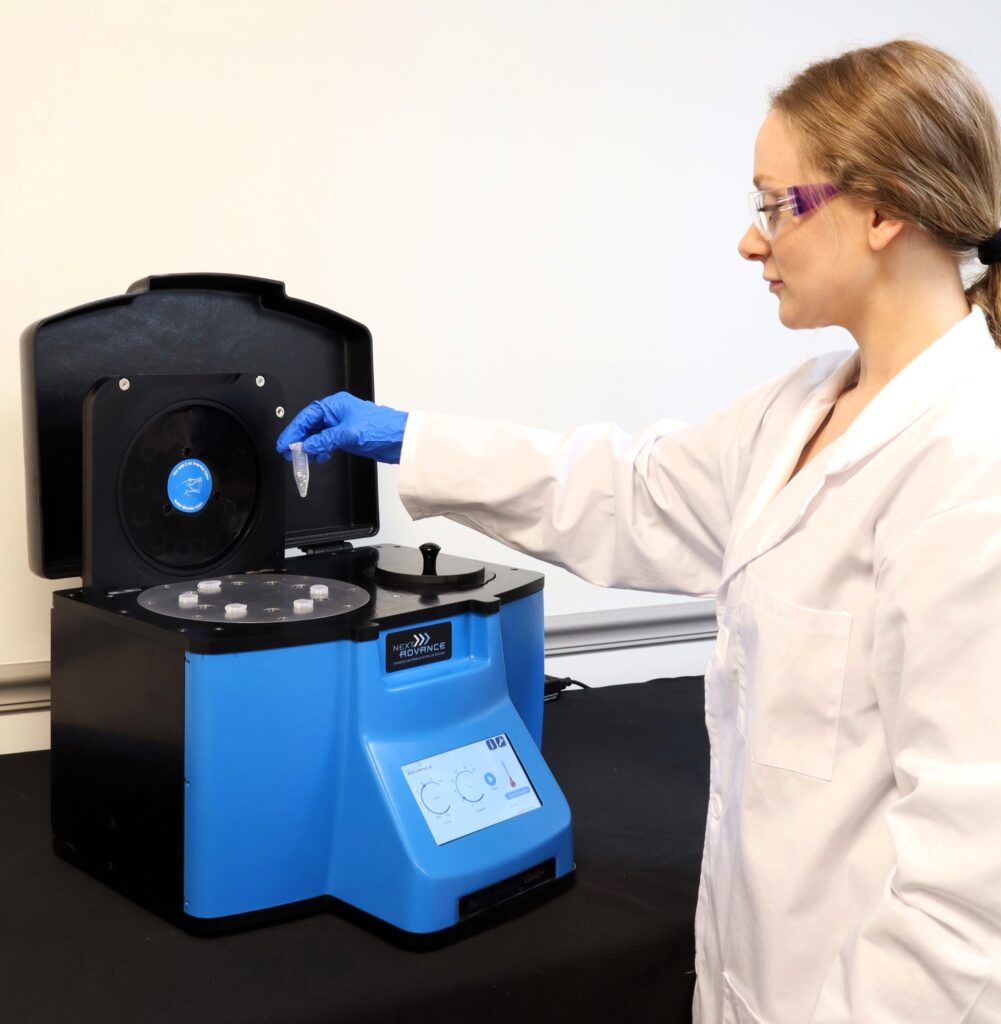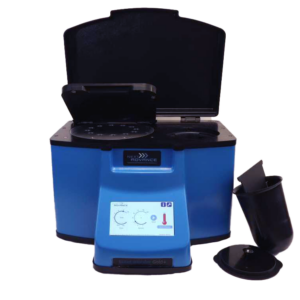Ideal for Cell Culture Homogenization
Do you spend lots of time and effort homogenizing cultured cells? The Bullet Blender® tissue homogenizer delivers high quality and superior yields. No other homogenizer comes close to delivering the Bullet Blender’s winning combination of top-quality performance and budget-friendly affordability. See below for a cultured cells homogenization protocol.
Save Time, Effort and Get Superior Results with
The Bullet Blender Homogenizer
Consistent and High Yield Results
Run up to 24 samples at the same time under microprocessor-controlled conditions, ensuring experimental reproducibility and high yield. Process samples from 10mg or less up to 3.5g.No Cross Contamination
No part of the Bullet Blender ever touches the tissue – the sample tubes are kept closed during homogenization. There are no probes to clean between samples.Samples Stay Cool
The Bullet Blenders’ innovative and elegant design provides convective cooling of the samples, so they do not heat up more than several degrees. In fact, our Gold+ models hold the sample temperature to about 4ºC.Easy and Convenient to Use
Just place beads and buffer along with your tissue sample in standard tubes, load tubes directly in the Bullet Blender, select time and speed, and press start.Risk Free Purchase
Thousands of peer-reviewed journal articles attest to the consistency and quality of the Bullet Blender homogenizer. We offer a 2 year warranty, extendable to 4 years, because our Bullet Blenders are reliable and last for many years.Cultured Cells Homogenization Protocol
Sample size |
See the Protocol |
| microcentrifuge tube model (up to 300 mg) | Small cell culture samples |
| 5mL tube model (100mg - 1g) | Medium cell culture samples |
| 50mL tube model (100mg - 3.5g) | Large cell culture samples |
What Else Can You Homogenize? Tough or Soft, No Problem!
The Bullet Blender can process a wide range of samples including organ tissue, cell culture, plant tissue, and small organisms. You can homogenize samples as tough as mouse femur or for gentle applications such as tissue dissociation or organelle isolation.

Want more guidance? Need a quote? Contact us:

Bullet Blender Models
Select Publications using the Bullet Blender to Homogenize Cultured Cells
2474232
cell culture
1
apa
50
date
desc
4123
https://www.nextadvance.com/wp-content/plugins/zotpress/
%7B%22status%22%3A%22success%22%2C%22updateneeded%22%3Afalse%2C%22instance%22%3Afalse%2C%22meta%22%3A%7B%22request_last%22%3A0%2C%22request_next%22%3A0%2C%22used_cache%22%3Atrue%7D%2C%22data%22%3A%5B%7B%22key%22%3A%222MADWFHW%22%2C%22library%22%3A%7B%22id%22%3A2474232%7D%2C%22meta%22%3A%7B%22creatorSummary%22%3A%22Zheng%20et%20al.%22%2C%22parsedDate%22%3A%222016-06%22%2C%22numChildren%22%3A2%7D%2C%22bib%22%3A%22%26lt%3Bdiv%20class%3D%26quot%3Bcsl-bib-body%26quot%3B%20style%3D%26quot%3Bline-height%3A%202%3B%20padding-left%3A%201em%3B%20text-indent%3A-1em%3B%26quot%3B%26gt%3B%5Cn%20%20%26lt%3Bdiv%20class%3D%26quot%3Bcsl-entry%26quot%3B%26gt%3BZheng%2C%20Y.%2C%20Xie%2C%20J.%2C%20Huang%2C%20X.%2C%20Dong%2C%20J.%2C%20Park%2C%20M.%20S.%2C%20%26amp%3B%20Chan%2C%20W.%20K.%20%282016%29.%20Binding%20studies%20using%20Pichia%20pastoris%20expressed%20human%20aryl%20hydrocarbon%20receptor%20and%20aryl%20hydrocarbon%20receptor%20nuclear%20translocator%20proteins.%20%26lt%3Bi%26gt%3BProtein%20Expression%20and%20Purification%26lt%3B%5C%2Fi%26gt%3B%2C%20%26lt%3Bi%26gt%3B122%26lt%3B%5C%2Fi%26gt%3B%2C%2072%26%23x2013%3B81.%20%26lt%3Ba%20class%3D%26%23039%3Bzp-DOIURL%26%23039%3B%20href%3D%26%23039%3Bhttps%3A%5C%2F%5C%2Fdoi.org%5C%2F10.1016%5C%2Fj.pep.2016.02.011%26%23039%3B%26gt%3Bhttps%3A%5C%2F%5C%2Fdoi.org%5C%2F10.1016%5C%2Fj.pep.2016.02.011%26lt%3B%5C%2Fa%26gt%3B%26lt%3B%5C%2Fdiv%26gt%3B%5Cn%26lt%3B%5C%2Fdiv%26gt%3B%22%2C%22data%22%3A%7B%22itemType%22%3A%22journalArticle%22%2C%22title%22%3A%22Binding%20studies%20using%20Pichia%20pastoris%20expressed%20human%20aryl%20hydrocarbon%20receptor%20and%20aryl%20hydrocarbon%20receptor%20nuclear%20translocator%20proteins%22%2C%22creators%22%3A%5B%7B%22creatorType%22%3A%22author%22%2C%22firstName%22%3A%22Yujuan%22%2C%22lastName%22%3A%22Zheng%22%7D%2C%7B%22creatorType%22%3A%22author%22%2C%22firstName%22%3A%22Jinghang%22%2C%22lastName%22%3A%22Xie%22%7D%2C%7B%22creatorType%22%3A%22author%22%2C%22firstName%22%3A%22Xin%22%2C%22lastName%22%3A%22Huang%22%7D%2C%7B%22creatorType%22%3A%22author%22%2C%22firstName%22%3A%22Jin%22%2C%22lastName%22%3A%22Dong%22%7D%2C%7B%22creatorType%22%3A%22author%22%2C%22firstName%22%3A%22Miki%20S.%22%2C%22lastName%22%3A%22Park%22%7D%2C%7B%22creatorType%22%3A%22author%22%2C%22firstName%22%3A%22William%20K.%22%2C%22lastName%22%3A%22Chan%22%7D%5D%2C%22abstractNote%22%3A%22The%20aryl%20hydrocarbon%20receptor%20%28AHR%29%20is%20a%20transcription%20factor%20which%20activates%20gene%20transcription%20by%20binding%20to%20its%20corresponding%20enhancer%20as%20the%20heterodimer%2C%20which%20is%20consisted%20of%20AHR%20and%20the%20aryl%20hydrocarbon%20receptor%20nuclear%20translocator%20%28ARNT%29.%20Human%20AHR%20can%20be%20rather%20difficult%20to%20study%2C%20when%20compared%20among%20the%20AHR%20of%20other%20species%2C%20since%20it%20is%20relatively%20unstable%20and%20less%20sensitive%20to%20some%20ligands%20in%5Cu00a0vitro.%20Overexpression%20of%20human%20AHR%20has%20been%20limited%20to%20the%20baculovirus%20expression%2C%20which%20is%20costly%20and%20tedious%20due%20to%20the%20need%20of%20repetitive%20baculovirus%20production.%20Here%20we%20explored%20whether%20we%20could%20generate%20abundant%20amounts%20of%20human%20AHR%20and%20ARNT%20in%20a%20better%20overexpression%20system%20for%20functional%20study.%20We%20observed%20that%20human%20AHR%20and%20ARNT%20can%20be%20expressed%20in%20Pichia%20pastoris%20with%20yields%20that%20are%20comparable%20to%20the%20baculovirus%20system%20only%20if%20their%20cDNAs%20are%20optimized%20for%20Pichia%20expression.%20Fusion%20with%20a%20c-myc%20tag%20at%20their%20C-termini%20seems%20to%20increase%20the%20expression%20yield.%20These%20Pichia%20expressed%20proteins%20can%20effectively%20heterodimerize%20and%20form%20the%20ternary%20AHR%5C%2FARNT%5C%2Fenhancer%20complex%20in%20the%20presence%20of%20%5Cu03b2-naphthoflavone%20or%20kynurenine.%20Limited%20proteolysis%20using%20thermolysin%20can%20be%20used%20to%20study%20the%20heterodimerization%20of%20these%20human%20AHR%20and%20ARNT%20proteins.%22%2C%22date%22%3A%22June%202016%22%2C%22language%22%3A%22%22%2C%22DOI%22%3A%2210.1016%5C%2Fj.pep.2016.02.011%22%2C%22ISSN%22%3A%221046-5928%22%2C%22url%22%3A%22http%3A%5C%2F%5C%2Fwww.sciencedirect.com%5C%2Fscience%5C%2Farticle%5C%2Fpii%5C%2FS1046592816300316%22%2C%22collections%22%3A%5B%22M2MNG549%22%5D%2C%22dateModified%22%3A%222016-06-24T15%3A24%3A33Z%22%7D%7D%2C%7B%22key%22%3A%2268UGIF4N%22%2C%22library%22%3A%7B%22id%22%3A2474232%7D%2C%22meta%22%3A%7B%22creatorSummary%22%3A%22Clark%20et%20al.%22%2C%22parsedDate%22%3A%222016-01-01%22%2C%22numChildren%22%3A2%7D%2C%22bib%22%3A%22%26lt%3Bdiv%20class%3D%26quot%3Bcsl-bib-body%26quot%3B%20style%3D%26quot%3Bline-height%3A%202%3B%20padding-left%3A%201em%3B%20text-indent%3A-1em%3B%26quot%3B%26gt%3B%5Cn%20%20%26lt%3Bdiv%20class%3D%26quot%3Bcsl-entry%26quot%3B%26gt%3BClark%2C%20D.%20J.%2C%20Mei%2C%20Y.%2C%20Sun%2C%20S.%2C%20Zhang%2C%20H.%2C%20Yang%2C%20A.%20J.%2C%20%26amp%3B%20Mao%2C%20L.%20%282016%29.%20Glycoproteomic%20Approach%20Identifies%20KRAS%20as%20a%20Positive%20Regulator%20of%20CREG1%20in%20Non-small%20Cell%20Lung%20Cancer%20Cells.%20%26lt%3Bi%26gt%3BTheranostics%26lt%3B%5C%2Fi%26gt%3B%2C%20%26lt%3Bi%26gt%3B6%26lt%3B%5C%2Fi%26gt%3B%281%29%2C%2065%26%23x2013%3B77.%20%26lt%3Ba%20class%3D%26%23039%3Bzp-DOIURL%26%23039%3B%20href%3D%26%23039%3Bhttps%3A%5C%2F%5C%2Fdoi.org%5C%2F10.7150%5C%2Fthno.12350%26%23039%3B%26gt%3Bhttps%3A%5C%2F%5C%2Fdoi.org%5C%2F10.7150%5C%2Fthno.12350%26lt%3B%5C%2Fa%26gt%3B%26lt%3B%5C%2Fdiv%26gt%3B%5Cn%26lt%3B%5C%2Fdiv%26gt%3B%22%2C%22data%22%3A%7B%22itemType%22%3A%22journalArticle%22%2C%22title%22%3A%22Glycoproteomic%20Approach%20Identifies%20KRAS%20as%20a%20Positive%20Regulator%20of%20CREG1%20in%20Non-small%20Cell%20Lung%20Cancer%20Cells%22%2C%22creators%22%3A%5B%7B%22creatorType%22%3A%22author%22%2C%22firstName%22%3A%22David%20J.%22%2C%22lastName%22%3A%22Clark%22%7D%2C%7B%22creatorType%22%3A%22author%22%2C%22firstName%22%3A%22Yuping%22%2C%22lastName%22%3A%22Mei%22%7D%2C%7B%22creatorType%22%3A%22author%22%2C%22firstName%22%3A%22Shisheng%22%2C%22lastName%22%3A%22Sun%22%7D%2C%7B%22creatorType%22%3A%22author%22%2C%22firstName%22%3A%22Hui%22%2C%22lastName%22%3A%22Zhang%22%7D%2C%7B%22creatorType%22%3A%22author%22%2C%22firstName%22%3A%22Austin%20J.%22%2C%22lastName%22%3A%22Yang%22%7D%2C%7B%22creatorType%22%3A%22author%22%2C%22firstName%22%3A%22Li%22%2C%22lastName%22%3A%22Mao%22%7D%5D%2C%22abstractNote%22%3A%22Protein%20glycosylation%20plays%20a%20fundamental%20role%20in%20a%20multitude%20of%20biological%20processes%2C%20and%20the%20associated%20aberrant%20expression%20of%20glycoproteins%20in%20cancer%20has%20made%20them%20attractive%20biomarkers%20and%20therapeutic%20targets.%20In%20this%20study%2C%20we%20examined%20differentially%20expressed%20glycoproteins%20in%20cell%20lines%20derived%20from%20three%20different%20states%20of%20lung%20tumorigenesis%3A%20an%20immortalized%20bronchial%20epithelial%20cell%20%28HBE%29%20line%2C%20a%20non-small%20cell%20lung%20cancer%20%28NSCLC%29%20cell%20line%20harboring%20a%20Kirsten%20rat%20sarcoma%20viral%20oncogene%20homolog%20%28KRAS%29%20activation%20mutation%20and%20a%20NSCLC%20cell%20line%20harboring%20an%20epidermal%20growth%20factor%20receptor%20%28EGFR%29%20activation%20deletion.%20Using%20a%20Triple%20SILAC%20proteomic%20quantification%20strategy%20paired%20with%20hydrazide%20chemistry%20N-linked%20glycopeptide%20enrichment%2C%20we%20quantified%20118%20glycopeptides%20in%20the%20three%20cell%20lines%20derived%20from%2082%20glycoproteins.%20Proteomic%20profiling%20revealed%2027%20glycopeptides%20overexpressed%20in%20both%20NSCLC%20cell%20lines%2C%206%20glycopeptides%20overexpressed%20only%20in%20the%20EGFR%20mutant%20cells%20and%2019%20glycopeptides%20overexpressed%20only%20in%20the%20KRAS%20mutant%20cells.%20Further%20investigation%20of%20a%20panel%20of%20NSCLC%20cell%20lines%20found%20that%20Cellular%20repressor%20of%20E1A-stimulated%20genes%20%28CREG1%29%20overexpression%20was%20closely%20correlated%20with%20KRAS%20mutation%20status%20in%20NSCLC%20cells%20and%20could%20be%20down-regulated%20by%20inhibition%20of%20KRAS%20expression.%20Our%20results%20indicate%20that%20CREG1%20is%20a%20down-stream%20effector%20of%20KRAS%20in%20a%20sub-type%20of%20NSCLC%20cells%20and%20a%20novel%20candidate%20biomarker%20or%20therapeutic%20target%20for%20KRAS%20mutant%20NSCLC.%22%2C%22date%22%3A%222016-1-1%22%2C%22language%22%3A%22%22%2C%22DOI%22%3A%2210.7150%5C%2Fthno.12350%22%2C%22ISSN%22%3A%221838-7640%22%2C%22url%22%3A%22http%3A%5C%2F%5C%2Fwww.ncbi.nlm.nih.gov%5C%2Fpmc%5C%2Farticles%5C%2FPMC4679355%5C%2F%22%2C%22collections%22%3A%5B%22M2MNG549%22%5D%2C%22dateModified%22%3A%222016-06-08T20%3A58%3A58Z%22%7D%7D%2C%7B%22key%22%3A%22Z6BDJ8EQ%22%2C%22library%22%3A%7B%22id%22%3A2474232%7D%2C%22meta%22%3A%7B%22creatorSummary%22%3A%22Tranchemontagne%20et%20al.%22%2C%22parsedDate%22%3A%222016%22%2C%22numChildren%22%3A0%7D%2C%22bib%22%3A%22%26lt%3Bdiv%20class%3D%26quot%3Bcsl-bib-body%26quot%3B%20style%3D%26quot%3Bline-height%3A%202%3B%20padding-left%3A%201em%3B%20text-indent%3A-1em%3B%26quot%3B%26gt%3B%5Cn%20%20%26lt%3Bdiv%20class%3D%26quot%3Bcsl-entry%26quot%3B%26gt%3BTranchemontagne%2C%20Z.%20R.%2C%20Camire%2C%20R.%20B.%2C%20O%26%23x2019%3BDonnell%2C%20V.%20J.%2C%20Baugh%2C%20J.%2C%20%26amp%3B%20Burkholder%2C%20K.%20M.%20%282016%29.%20Staphylococcus%20aureus%20Strain%20USA300%20Perturbs%20Acquisition%20of%20Lysosomal%20Enzymes%20and%20Requires%20Phagosomal%20Acidification%20for%20Survival%20inside%20Macrophages.%20%26lt%3Bi%26gt%3BInfection%20and%20Immunity%26lt%3B%5C%2Fi%26gt%3B%2C%20%26lt%3Bi%26gt%3B84%26lt%3B%5C%2Fi%26gt%3B%281%29%2C%20241%26%23x2013%3B253.%20%26lt%3Ba%20class%3D%26%23039%3Bzp-DOIURL%26%23039%3B%20href%3D%26%23039%3Bhttps%3A%5C%2F%5C%2Fdoi.org%5C%2F10.1128%5C%2FIAI.00704-15%26%23039%3B%26gt%3Bhttps%3A%5C%2F%5C%2Fdoi.org%5C%2F10.1128%5C%2FIAI.00704-15%26lt%3B%5C%2Fa%26gt%3B%26lt%3B%5C%2Fdiv%26gt%3B%5Cn%26lt%3B%5C%2Fdiv%26gt%3B%22%2C%22data%22%3A%7B%22itemType%22%3A%22journalArticle%22%2C%22title%22%3A%22Staphylococcus%20aureus%20Strain%20USA300%20Perturbs%20Acquisition%20of%20Lysosomal%20Enzymes%20and%20Requires%20Phagosomal%20Acidification%20for%20Survival%20inside%20Macrophages%22%2C%22creators%22%3A%5B%7B%22creatorType%22%3A%22author%22%2C%22firstName%22%3A%22Zachary%20R.%22%2C%22lastName%22%3A%22Tranchemontagne%22%7D%2C%7B%22creatorType%22%3A%22author%22%2C%22firstName%22%3A%22Ryan%20B.%22%2C%22lastName%22%3A%22Camire%22%7D%2C%7B%22creatorType%22%3A%22author%22%2C%22firstName%22%3A%22Vanessa%20J.%22%2C%22lastName%22%3A%22O%27Donnell%22%7D%2C%7B%22creatorType%22%3A%22author%22%2C%22firstName%22%3A%22Jessfor%22%2C%22lastName%22%3A%22Baugh%22%7D%2C%7B%22creatorType%22%3A%22author%22%2C%22firstName%22%3A%22Kristin%20M.%22%2C%22lastName%22%3A%22Burkholder%22%7D%2C%7B%22creatorType%22%3A%22editor%22%2C%22firstName%22%3A%22C.%20R.%22%2C%22lastName%22%3A%22Roy%22%7D%5D%2C%22abstractNote%22%3A%22%22%2C%22date%22%3A%2201%5C%2F2016%22%2C%22language%22%3A%22en%22%2C%22DOI%22%3A%2210.1128%5C%2FIAI.00704-15%22%2C%22ISSN%22%3A%220019-9567%2C%201098-5522%22%2C%22url%22%3A%22http%3A%5C%2F%5C%2Fiai.asm.org%5C%2Flookup%5C%2Fdoi%5C%2F10.1128%5C%2FIAI.00704-15%22%2C%22collections%22%3A%5B%22M2MNG549%22%5D%2C%22dateModified%22%3A%222015-12-31T19%3A49%3A06Z%22%7D%7D%2C%7B%22key%22%3A%22EH35A4UE%22%2C%22library%22%3A%7B%22id%22%3A2474232%7D%2C%22meta%22%3A%7B%22creatorSummary%22%3A%22Wilde%20et%20al.%22%2C%22parsedDate%22%3A%222015-12-18%22%2C%22numChildren%22%3A0%7D%2C%22bib%22%3A%22%26lt%3Bdiv%20class%3D%26quot%3Bcsl-bib-body%26quot%3B%20style%3D%26quot%3Bline-height%3A%202%3B%20padding-left%3A%201em%3B%20text-indent%3A-1em%3B%26quot%3B%26gt%3B%5Cn%20%20%26lt%3Bdiv%20class%3D%26quot%3Bcsl-entry%26quot%3B%26gt%3BWilde%2C%20A.%20D.%2C%20Snyder%2C%20D.%20J.%2C%20Putnam%2C%20N.%20E.%2C%20Valentino%2C%20M.%20D.%2C%20Hammer%2C%20N.%20D.%2C%20Lonergan%2C%20Z.%20R.%2C%20Hinger%2C%20S.%20A.%2C%20Aysanoa%2C%20E.%20E.%2C%20Blanchard%2C%20C.%2C%20Dunman%2C%20P.%20M.%2C%20Wasserman%2C%20G.%20A.%2C%20Chen%2C%20J.%2C%20Shopsin%2C%20B.%2C%20Gilmore%2C%20M.%20S.%2C%20Skaar%2C%20E.%20P.%2C%20%26amp%3B%20Cassat%2C%20J.%20E.%20%282015%29.%20Bacterial%20Hypoxic%20Responses%20Revealed%20as%20Critical%20Determinants%20of%20the%20Host-Pathogen%20Outcome%20by%20TnSeq%20Analysis%20of%20Staphylococcus%20aureus%20Invasive%20Infection.%20%26lt%3Bi%26gt%3BPLOS%20Pathogens%26lt%3B%5C%2Fi%26gt%3B%2C%20%26lt%3Bi%26gt%3B11%26lt%3B%5C%2Fi%26gt%3B%2812%29%2C%20e1005341.%20%26lt%3Ba%20class%3D%26%23039%3Bzp-DOIURL%26%23039%3B%20href%3D%26%23039%3Bhttps%3A%5C%2F%5C%2Fdoi.org%5C%2F10.1371%5C%2Fjournal.ppat.1005341%26%23039%3B%26gt%3Bhttps%3A%5C%2F%5C%2Fdoi.org%5C%2F10.1371%5C%2Fjournal.ppat.1005341%26lt%3B%5C%2Fa%26gt%3B%26lt%3B%5C%2Fdiv%26gt%3B%5Cn%26lt%3B%5C%2Fdiv%26gt%3B%22%2C%22data%22%3A%7B%22itemType%22%3A%22journalArticle%22%2C%22title%22%3A%22Bacterial%20Hypoxic%20Responses%20Revealed%20as%20Critical%20Determinants%20of%20the%20Host-Pathogen%20Outcome%20by%20TnSeq%20Analysis%20of%20Staphylococcus%20aureus%20Invasive%20Infection%22%2C%22creators%22%3A%5B%7B%22creatorType%22%3A%22author%22%2C%22firstName%22%3A%22Aimee%20D.%22%2C%22lastName%22%3A%22Wilde%22%7D%2C%7B%22creatorType%22%3A%22author%22%2C%22firstName%22%3A%22Daniel%20J.%22%2C%22lastName%22%3A%22Snyder%22%7D%2C%7B%22creatorType%22%3A%22author%22%2C%22firstName%22%3A%22Nicole%20E.%22%2C%22lastName%22%3A%22Putnam%22%7D%2C%7B%22creatorType%22%3A%22author%22%2C%22firstName%22%3A%22Michael%20D.%22%2C%22lastName%22%3A%22Valentino%22%7D%2C%7B%22creatorType%22%3A%22author%22%2C%22firstName%22%3A%22Neal%20D.%22%2C%22lastName%22%3A%22Hammer%22%7D%2C%7B%22creatorType%22%3A%22author%22%2C%22firstName%22%3A%22Zachery%20R.%22%2C%22lastName%22%3A%22Lonergan%22%7D%2C%7B%22creatorType%22%3A%22author%22%2C%22firstName%22%3A%22Scott%20A.%22%2C%22lastName%22%3A%22Hinger%22%7D%2C%7B%22creatorType%22%3A%22author%22%2C%22firstName%22%3A%22Esar%20E.%22%2C%22lastName%22%3A%22Aysanoa%22%7D%2C%7B%22creatorType%22%3A%22author%22%2C%22firstName%22%3A%22Catlyn%22%2C%22lastName%22%3A%22Blanchard%22%7D%2C%7B%22creatorType%22%3A%22author%22%2C%22firstName%22%3A%22Paul%20M.%22%2C%22lastName%22%3A%22Dunman%22%7D%2C%7B%22creatorType%22%3A%22author%22%2C%22firstName%22%3A%22Gregory%20A.%22%2C%22lastName%22%3A%22Wasserman%22%7D%2C%7B%22creatorType%22%3A%22author%22%2C%22firstName%22%3A%22John%22%2C%22lastName%22%3A%22Chen%22%7D%2C%7B%22creatorType%22%3A%22author%22%2C%22firstName%22%3A%22Bo%22%2C%22lastName%22%3A%22Shopsin%22%7D%2C%7B%22creatorType%22%3A%22author%22%2C%22firstName%22%3A%22Michael%20S.%22%2C%22lastName%22%3A%22Gilmore%22%7D%2C%7B%22creatorType%22%3A%22author%22%2C%22firstName%22%3A%22Eric%20P.%22%2C%22lastName%22%3A%22Skaar%22%7D%2C%7B%22creatorType%22%3A%22author%22%2C%22firstName%22%3A%22James%20E.%22%2C%22lastName%22%3A%22Cassat%22%7D%2C%7B%22creatorType%22%3A%22editor%22%2C%22firstName%22%3A%22Michael%22%2C%22lastName%22%3A%22Otto%22%7D%5D%2C%22abstractNote%22%3A%22%22%2C%22date%22%3A%222015-12-18%22%2C%22language%22%3A%22en%22%2C%22DOI%22%3A%2210.1371%5C%2Fjournal.ppat.1005341%22%2C%22ISSN%22%3A%221553-7374%22%2C%22url%22%3A%22http%3A%5C%2F%5C%2Fdx.plos.org%5C%2F10.1371%5C%2Fjournal.ppat.1005341%22%2C%22collections%22%3A%5B%22M2MNG549%22%5D%2C%22dateModified%22%3A%222016-01-11T20%3A10%3A00Z%22%7D%7D%2C%7B%22key%22%3A%22GTXA48W3%22%2C%22library%22%3A%7B%22id%22%3A2474232%7D%2C%22meta%22%3A%7B%22creatorSummary%22%3A%22Meyer%20et%20al.%22%2C%22parsedDate%22%3A%222015-09-01%22%2C%22numChildren%22%3A0%7D%2C%22bib%22%3A%22%26lt%3Bdiv%20class%3D%26quot%3Bcsl-bib-body%26quot%3B%20style%3D%26quot%3Bline-height%3A%202%3B%20padding-left%3A%201em%3B%20text-indent%3A-1em%3B%26quot%3B%26gt%3B%5Cn%20%20%26lt%3Bdiv%20class%3D%26quot%3Bcsl-entry%26quot%3B%26gt%3BMeyer%2C%20R.%20E.%2C%20Chuong%2C%20H.%20H.%2C%20Hild%2C%20M.%2C%20Hansen%2C%20C.%20L.%2C%20Kinter%2C%20M.%2C%20%26amp%3B%20Dawson%2C%20D.%20S.%20%282015%29.%20Ipl1%5C%2FAurora-B%20is%20necessary%20for%20kinetochore%20restructuring%20in%20meiosis%20I%20in%20Saccharomyces%20cerevisiae.%20%26lt%3Bi%26gt%3BMolecular%20Biology%20of%20the%20Cell%26lt%3B%5C%2Fi%26gt%3B%2C%20%26lt%3Bi%26gt%3B26%26lt%3B%5C%2Fi%26gt%3B%2817%29%2C%202986%26%23x2013%3B3000.%20%26lt%3Ba%20class%3D%26%23039%3Bzp-DOIURL%26%23039%3B%20href%3D%26%23039%3Bhttps%3A%5C%2F%5C%2Fdoi.org%5C%2F10.1091%5C%2Fmbc.E15-01-0032%26%23039%3B%26gt%3Bhttps%3A%5C%2F%5C%2Fdoi.org%5C%2F10.1091%5C%2Fmbc.E15-01-0032%26lt%3B%5C%2Fa%26gt%3B%26lt%3B%5C%2Fdiv%26gt%3B%5Cn%26lt%3B%5C%2Fdiv%26gt%3B%22%2C%22data%22%3A%7B%22itemType%22%3A%22journalArticle%22%2C%22title%22%3A%22Ipl1%5C%2FAurora-B%20is%20necessary%20for%20kinetochore%20restructuring%20in%20meiosis%20I%20in%20Saccharomyces%20cerevisiae%22%2C%22creators%22%3A%5B%7B%22creatorType%22%3A%22author%22%2C%22firstName%22%3A%22R.%20E.%22%2C%22lastName%22%3A%22Meyer%22%7D%2C%7B%22creatorType%22%3A%22author%22%2C%22firstName%22%3A%22H.%20H.%22%2C%22lastName%22%3A%22Chuong%22%7D%2C%7B%22creatorType%22%3A%22author%22%2C%22firstName%22%3A%22M.%22%2C%22lastName%22%3A%22Hild%22%7D%2C%7B%22creatorType%22%3A%22author%22%2C%22firstName%22%3A%22C.%20L.%22%2C%22lastName%22%3A%22Hansen%22%7D%2C%7B%22creatorType%22%3A%22author%22%2C%22firstName%22%3A%22M.%22%2C%22lastName%22%3A%22Kinter%22%7D%2C%7B%22creatorType%22%3A%22author%22%2C%22firstName%22%3A%22D.%20S.%22%2C%22lastName%22%3A%22Dawson%22%7D%5D%2C%22abstractNote%22%3A%22%22%2C%22date%22%3A%222015-09-01%22%2C%22language%22%3A%22en%22%2C%22DOI%22%3A%2210.1091%5C%2Fmbc.E15-01-0032%22%2C%22ISSN%22%3A%221059-1524%22%2C%22url%22%3A%22http%3A%5C%2F%5C%2Fwww.molbiolcell.org%5C%2Fcgi%5C%2Fdoi%5C%2F10.1091%5C%2Fmbc.E15-01-0032%22%2C%22collections%22%3A%5B%22M2MNG549%22%5D%2C%22dateModified%22%3A%222015-12-31T21%3A13%3A17Z%22%7D%7D%2C%7B%22key%22%3A%22UHIGFBFN%22%2C%22library%22%3A%7B%22id%22%3A2474232%7D%2C%22meta%22%3A%7B%22creatorSummary%22%3A%22Dragunow%20et%20al.%22%2C%22parsedDate%22%3A%222015-08-05%22%2C%22numChildren%22%3A0%7D%2C%22bib%22%3A%22%26lt%3Bdiv%20class%3D%26quot%3Bcsl-bib-body%26quot%3B%20style%3D%26quot%3Bline-height%3A%202%3B%20padding-left%3A%201em%3B%20text-indent%3A-1em%3B%26quot%3B%26gt%3B%5Cn%20%20%26lt%3Bdiv%20class%3D%26quot%3Bcsl-entry%26quot%3B%26gt%3BDragunow%2C%20M.%2C%20Feng%2C%20S.%2C%20Rustenhoven%2C%20J.%2C%20Curtis%2C%20M.%2C%20%26amp%3B%20Faull%2C%20R.%20%282015%29.%20Studying%20Human%20Brain%20Inflammation%20in%20Leptomeningeal%20and%20Choroid%20Plexus%20Explant%20Cultures.%20%26lt%3Bi%26gt%3BNeurochemical%20Research%26lt%3B%5C%2Fi%26gt%3B.%20%26lt%3Ba%20class%3D%26%23039%3Bzp-DOIURL%26%23039%3B%20href%3D%26%23039%3Bhttps%3A%5C%2F%5C%2Fdoi.org%5C%2F10.1007%5C%2Fs11064-015-1682-2%26%23039%3B%26gt%3Bhttps%3A%5C%2F%5C%2Fdoi.org%5C%2F10.1007%5C%2Fs11064-015-1682-2%26lt%3B%5C%2Fa%26gt%3B%26lt%3B%5C%2Fdiv%26gt%3B%5Cn%26lt%3B%5C%2Fdiv%26gt%3B%22%2C%22data%22%3A%7B%22itemType%22%3A%22journalArticle%22%2C%22title%22%3A%22Studying%20Human%20Brain%20Inflammation%20in%20Leptomeningeal%20and%20Choroid%20Plexus%20Explant%20Cultures%22%2C%22creators%22%3A%5B%7B%22creatorType%22%3A%22author%22%2C%22firstName%22%3A%22Mike%22%2C%22lastName%22%3A%22Dragunow%22%7D%2C%7B%22creatorType%22%3A%22author%22%2C%22firstName%22%3A%22Sheryl%22%2C%22lastName%22%3A%22Feng%22%7D%2C%7B%22creatorType%22%3A%22author%22%2C%22firstName%22%3A%22Justin%22%2C%22lastName%22%3A%22Rustenhoven%22%7D%2C%7B%22creatorType%22%3A%22author%22%2C%22firstName%22%3A%22Maurice%22%2C%22lastName%22%3A%22Curtis%22%7D%2C%7B%22creatorType%22%3A%22author%22%2C%22firstName%22%3A%22Richard%22%2C%22lastName%22%3A%22Faull%22%7D%5D%2C%22abstractNote%22%3A%22%22%2C%22date%22%3A%222015-8-5%22%2C%22language%22%3A%22en%22%2C%22DOI%22%3A%2210.1007%5C%2Fs11064-015-1682-2%22%2C%22ISSN%22%3A%220364-3190%2C%201573-6903%22%2C%22url%22%3A%22http%3A%5C%2F%5C%2Flink.springer.com%5C%2F10.1007%5C%2Fs11064-015-1682-2%22%2C%22collections%22%3A%5B%22M2MNG549%22%5D%2C%22dateModified%22%3A%222015-12-30T15%3A11%3A19Z%22%7D%7D%2C%7B%22key%22%3A%22QA9T8G2K%22%2C%22library%22%3A%7B%22id%22%3A2474232%7D%2C%22meta%22%3A%7B%22creatorSummary%22%3A%22Desai%20et%20al.%22%2C%22parsedDate%22%3A%222015-07-24%22%2C%22numChildren%22%3A0%7D%2C%22bib%22%3A%22%26lt%3Bdiv%20class%3D%26quot%3Bcsl-bib-body%26quot%3B%20style%3D%26quot%3Bline-height%3A%202%3B%20padding-left%3A%201em%3B%20text-indent%3A-1em%3B%26quot%3B%26gt%3B%5Cn%20%20%26lt%3Bdiv%20class%3D%26quot%3Bcsl-entry%26quot%3B%26gt%3BDesai%2C%20J.%2C%20Cheng%2C%20S.%2C%20Ying%2C%20T.%2C%20Nguyen%2C%20M.%2C%20Clancy%2C%20C.%2C%20Lanni%2C%20F.%2C%20%26amp%3B%20Mitchell%2C%20A.%20%282015%29.%20Coordination%20of%20Candida%20albicans%20Invasion%20and%20Infection%20Functions%20by%20Phosphoglycerol%20Phosphatase%20Rhr2.%20%26lt%3Bi%26gt%3BPathogens%26lt%3B%5C%2Fi%26gt%3B%2C%20%26lt%3Bi%26gt%3B4%26lt%3B%5C%2Fi%26gt%3B%283%29%2C%20573%26%23x2013%3B589.%20%26lt%3Ba%20class%3D%26%23039%3Bzp-DOIURL%26%23039%3B%20href%3D%26%23039%3Bhttps%3A%5C%2F%5C%2Fdoi.org%5C%2F10.3390%5C%2Fpathogens4030573%26%23039%3B%26gt%3Bhttps%3A%5C%2F%5C%2Fdoi.org%5C%2F10.3390%5C%2Fpathogens4030573%26lt%3B%5C%2Fa%26gt%3B%26lt%3B%5C%2Fdiv%26gt%3B%5Cn%26lt%3B%5C%2Fdiv%26gt%3B%22%2C%22data%22%3A%7B%22itemType%22%3A%22journalArticle%22%2C%22title%22%3A%22Coordination%20of%20Candida%20albicans%20Invasion%20and%20Infection%20Functions%20by%20Phosphoglycerol%20Phosphatase%20Rhr2%22%2C%22creators%22%3A%5B%7B%22creatorType%22%3A%22author%22%2C%22firstName%22%3A%22Jigar%22%2C%22lastName%22%3A%22Desai%22%7D%2C%7B%22creatorType%22%3A%22author%22%2C%22firstName%22%3A%22Shaoji%22%2C%22lastName%22%3A%22Cheng%22%7D%2C%7B%22creatorType%22%3A%22author%22%2C%22firstName%22%3A%22Tammy%22%2C%22lastName%22%3A%22Ying%22%7D%2C%7B%22creatorType%22%3A%22author%22%2C%22firstName%22%3A%22M.%22%2C%22lastName%22%3A%22Nguyen%22%7D%2C%7B%22creatorType%22%3A%22author%22%2C%22firstName%22%3A%22Cornelius%22%2C%22lastName%22%3A%22Clancy%22%7D%2C%7B%22creatorType%22%3A%22author%22%2C%22firstName%22%3A%22Frederick%22%2C%22lastName%22%3A%22Lanni%22%7D%2C%7B%22creatorType%22%3A%22author%22%2C%22firstName%22%3A%22Aaron%22%2C%22lastName%22%3A%22Mitchell%22%7D%5D%2C%22abstractNote%22%3A%22%22%2C%22date%22%3A%222015-07-24%22%2C%22language%22%3A%22en%22%2C%22DOI%22%3A%2210.3390%5C%2Fpathogens4030573%22%2C%22ISSN%22%3A%222076-0817%22%2C%22url%22%3A%22http%3A%5C%2F%5C%2Fwww.mdpi.com%5C%2F2076-0817%5C%2F4%5C%2F3%5C%2F573%5C%2F%22%2C%22collections%22%3A%5B%22M2MNG549%22%5D%2C%22dateModified%22%3A%222015-12-31T21%3A41%3A55Z%22%7D%7D%2C%7B%22key%22%3A%22EGU97KVT%22%2C%22library%22%3A%7B%22id%22%3A2474232%7D%2C%22meta%22%3A%7B%22creatorSummary%22%3A%22Ran%20et%20al.%22%2C%22parsedDate%22%3A%222015-07-01%22%2C%22numChildren%22%3A0%7D%2C%22bib%22%3A%22%26lt%3Bdiv%20class%3D%26quot%3Bcsl-bib-body%26quot%3B%20style%3D%26quot%3Bline-height%3A%202%3B%20padding-left%3A%201em%3B%20text-indent%3A-1em%3B%26quot%3B%26gt%3B%5Cn%20%20%26lt%3Bdiv%20class%3D%26quot%3Bcsl-entry%26quot%3B%26gt%3BRan%2C%20L.%2C%20Yu%2C%20Q.%2C%20Zhang%2C%20S.%2C%20Xiong%2C%20F.%2C%20Cheng%2C%20J.%2C%20Yang%2C%20P.%2C%20Xu%2C%20J.-F.%2C%20Nie%2C%20H.%2C%20Zhong%2C%20Q.%2C%20Yang%2C%20X.%2C%20Yang%2C%20F.%2C%20Gong%2C%20Q.%2C%20Kuczma%2C%20M.%2C%20Kraj%2C%20P.%2C%20Gu%2C%20W.%2C%20Ren%2C%20B.-X.%2C%20%26amp%3B%20Wang%2C%20C.-Y.%20%282015%29.%20Cx3cr1%20deficiency%20in%20mice%20attenuates%20hepatic%20granuloma%20formation%20during%20acute%20schistosomiasis%20by%20enhancing%20the%20M2-type%20polarization%20of%20macrophages.%20%26lt%3Bi%26gt%3BDisease%20Models%20%26amp%3B%20Mechanisms%26lt%3B%5C%2Fi%26gt%3B%2C%20%26lt%3Bi%26gt%3B8%26lt%3B%5C%2Fi%26gt%3B%287%29%2C%20691%26%23x2013%3B700.%20%26lt%3Ba%20class%3D%26%23039%3Bzp-DOIURL%26%23039%3B%20href%3D%26%23039%3Bhttps%3A%5C%2F%5C%2Fdoi.org%5C%2F10.1242%5C%2Fdmm.018242%26%23039%3B%26gt%3Bhttps%3A%5C%2F%5C%2Fdoi.org%5C%2F10.1242%5C%2Fdmm.018242%26lt%3B%5C%2Fa%26gt%3B%26lt%3B%5C%2Fdiv%26gt%3B%5Cn%26lt%3B%5C%2Fdiv%26gt%3B%22%2C%22data%22%3A%7B%22itemType%22%3A%22journalArticle%22%2C%22title%22%3A%22Cx3cr1%20deficiency%20in%20mice%20attenuates%20hepatic%20granuloma%20formation%20during%20acute%20schistosomiasis%20by%20enhancing%20the%20M2-type%20polarization%20of%20macrophages%22%2C%22creators%22%3A%5B%7B%22creatorType%22%3A%22author%22%2C%22firstName%22%3A%22L.%22%2C%22lastName%22%3A%22Ran%22%7D%2C%7B%22creatorType%22%3A%22author%22%2C%22firstName%22%3A%22Q.%22%2C%22lastName%22%3A%22Yu%22%7D%2C%7B%22creatorType%22%3A%22author%22%2C%22firstName%22%3A%22S.%22%2C%22lastName%22%3A%22Zhang%22%7D%2C%7B%22creatorType%22%3A%22author%22%2C%22firstName%22%3A%22F.%22%2C%22lastName%22%3A%22Xiong%22%7D%2C%7B%22creatorType%22%3A%22author%22%2C%22firstName%22%3A%22J.%22%2C%22lastName%22%3A%22Cheng%22%7D%2C%7B%22creatorType%22%3A%22author%22%2C%22firstName%22%3A%22P.%22%2C%22lastName%22%3A%22Yang%22%7D%2C%7B%22creatorType%22%3A%22author%22%2C%22firstName%22%3A%22J.-F.%22%2C%22lastName%22%3A%22Xu%22%7D%2C%7B%22creatorType%22%3A%22author%22%2C%22firstName%22%3A%22H.%22%2C%22lastName%22%3A%22Nie%22%7D%2C%7B%22creatorType%22%3A%22author%22%2C%22firstName%22%3A%22Q.%22%2C%22lastName%22%3A%22Zhong%22%7D%2C%7B%22creatorType%22%3A%22author%22%2C%22firstName%22%3A%22X.%22%2C%22lastName%22%3A%22Yang%22%7D%2C%7B%22creatorType%22%3A%22author%22%2C%22firstName%22%3A%22F.%22%2C%22lastName%22%3A%22Yang%22%7D%2C%7B%22creatorType%22%3A%22author%22%2C%22firstName%22%3A%22Q.%22%2C%22lastName%22%3A%22Gong%22%7D%2C%7B%22creatorType%22%3A%22author%22%2C%22firstName%22%3A%22M.%22%2C%22lastName%22%3A%22Kuczma%22%7D%2C%7B%22creatorType%22%3A%22author%22%2C%22firstName%22%3A%22P.%22%2C%22lastName%22%3A%22Kraj%22%7D%2C%7B%22creatorType%22%3A%22author%22%2C%22firstName%22%3A%22W.%22%2C%22lastName%22%3A%22Gu%22%7D%2C%7B%22creatorType%22%3A%22author%22%2C%22firstName%22%3A%22B.-X.%22%2C%22lastName%22%3A%22Ren%22%7D%2C%7B%22creatorType%22%3A%22author%22%2C%22firstName%22%3A%22C.-Y.%22%2C%22lastName%22%3A%22Wang%22%7D%5D%2C%22abstractNote%22%3A%22%22%2C%22date%22%3A%222015-07-01%22%2C%22language%22%3A%22en%22%2C%22DOI%22%3A%2210.1242%5C%2Fdmm.018242%22%2C%22ISSN%22%3A%221754-8403%2C%201754-8411%22%2C%22url%22%3A%22http%3A%5C%2F%5C%2Fdmm.biologists.org%5C%2Fcgi%5C%2Fdoi%5C%2F10.1242%5C%2Fdmm.018242%22%2C%22collections%22%3A%5B%22M2MNG549%22%5D%2C%22dateModified%22%3A%222015-12-31T21%3A35%3A14Z%22%7D%7D%2C%7B%22key%22%3A%22RDBF8WQ4%22%2C%22library%22%3A%7B%22id%22%3A2474232%7D%2C%22meta%22%3A%7B%22creatorSummary%22%3A%22Zhang%20et%20al.%22%2C%22parsedDate%22%3A%222015-03-31%22%2C%22numChildren%22%3A0%7D%2C%22bib%22%3A%22%26lt%3Bdiv%20class%3D%26quot%3Bcsl-bib-body%26quot%3B%20style%3D%26quot%3Bline-height%3A%202%3B%20padding-left%3A%201em%3B%20text-indent%3A-1em%3B%26quot%3B%26gt%3B%5Cn%20%20%26lt%3Bdiv%20class%3D%26quot%3Bcsl-entry%26quot%3B%26gt%3BZhang%2C%20L.%2C%20Li%2C%20X.%2C%20Hill%2C%20R.%20C.%2C%20Qiu%2C%20Y.%2C%20Zhang%2C%20W.%2C%20Hansen%2C%20K.%20C.%2C%20%26amp%3B%20Zhao%2C%20R.%20%282015%29.%20Brr2%20plays%20a%20role%20in%20spliceosomal%20activation%20in%20addition%20to%20U4%5C%2FU6%20unwinding.%20%26lt%3Bi%26gt%3BNucleic%20Acids%20Research%26lt%3B%5C%2Fi%26gt%3B%2C%20%26lt%3Bi%26gt%3B43%26lt%3B%5C%2Fi%26gt%3B%286%29%2C%203286%26%23x2013%3B3297.%20%26lt%3Ba%20class%3D%26%23039%3Bzp-DOIURL%26%23039%3B%20href%3D%26%23039%3Bhttps%3A%5C%2F%5C%2Fdoi.org%5C%2F10.1093%5C%2Fnar%5C%2Fgkv062%26%23039%3B%26gt%3Bhttps%3A%5C%2F%5C%2Fdoi.org%5C%2F10.1093%5C%2Fnar%5C%2Fgkv062%26lt%3B%5C%2Fa%26gt%3B%26lt%3B%5C%2Fdiv%26gt%3B%5Cn%26lt%3B%5C%2Fdiv%26gt%3B%22%2C%22data%22%3A%7B%22itemType%22%3A%22journalArticle%22%2C%22title%22%3A%22Brr2%20plays%20a%20role%20in%20spliceosomal%20activation%20in%20addition%20to%20U4%5C%2FU6%20unwinding%22%2C%22creators%22%3A%5B%7B%22creatorType%22%3A%22author%22%2C%22firstName%22%3A%22L.%22%2C%22lastName%22%3A%22Zhang%22%7D%2C%7B%22creatorType%22%3A%22author%22%2C%22firstName%22%3A%22X.%22%2C%22lastName%22%3A%22Li%22%7D%2C%7B%22creatorType%22%3A%22author%22%2C%22firstName%22%3A%22R.%20C.%22%2C%22lastName%22%3A%22Hill%22%7D%2C%7B%22creatorType%22%3A%22author%22%2C%22firstName%22%3A%22Y.%22%2C%22lastName%22%3A%22Qiu%22%7D%2C%7B%22creatorType%22%3A%22author%22%2C%22firstName%22%3A%22W.%22%2C%22lastName%22%3A%22Zhang%22%7D%2C%7B%22creatorType%22%3A%22author%22%2C%22firstName%22%3A%22K.%20C.%22%2C%22lastName%22%3A%22Hansen%22%7D%2C%7B%22creatorType%22%3A%22author%22%2C%22firstName%22%3A%22R.%22%2C%22lastName%22%3A%22Zhao%22%7D%5D%2C%22abstractNote%22%3A%22%22%2C%22date%22%3A%222015-03-31%22%2C%22language%22%3A%22en%22%2C%22DOI%22%3A%2210.1093%5C%2Fnar%5C%2Fgkv062%22%2C%22ISSN%22%3A%220305-1048%2C%201362-4962%22%2C%22url%22%3A%22http%3A%5C%2F%5C%2Fnar.oxfordjournals.org%5C%2Flookup%5C%2Fdoi%5C%2F10.1093%5C%2Fnar%5C%2Fgkv062%22%2C%22collections%22%3A%5B%22M2MNG549%22%5D%2C%22dateModified%22%3A%222015-12-31T19%3A44%3A28Z%22%7D%7D%2C%7B%22key%22%3A%22Q8HRR7N7%22%2C%22library%22%3A%7B%22id%22%3A2474232%7D%2C%22meta%22%3A%7B%22creatorSummary%22%3A%22Behnia%20et%20al.%22%2C%22parsedDate%22%3A%222015%22%2C%22numChildren%22%3A0%7D%2C%22bib%22%3A%22%26lt%3Bdiv%20class%3D%26quot%3Bcsl-bib-body%26quot%3B%20style%3D%26quot%3Bline-height%3A%202%3B%20padding-left%3A%201em%3B%20text-indent%3A-1em%3B%26quot%3B%26gt%3B%5Cn%20%20%26lt%3Bdiv%20class%3D%26quot%3Bcsl-entry%26quot%3B%26gt%3BBehnia%2C%20F.%2C%20Peltier%2C%20M.%20R.%2C%20Saade%2C%20G.%20R.%2C%20%26amp%3B%20Menon%2C%20R.%20%282015%29.%20Environmental%20Pollutant%20Polybrominated%20Diphenyl%20Ether%2C%20a%20Flame%20Retardant%2C%20Induces%20Primary%20Amnion%20Cell%20Senescence.%20%26lt%3Bi%26gt%3BAmerican%20Journal%20of%20Reproductive%20Immunology%26lt%3B%5C%2Fi%26gt%3B%2C%20%26lt%3Bi%26gt%3B74%26lt%3B%5C%2Fi%26gt%3B%285%29%2C%20398%26%23x2013%3B406.%20%26lt%3Ba%20class%3D%26%23039%3Bzp-DOIURL%26%23039%3B%20href%3D%26%23039%3Bhttps%3A%5C%2F%5C%2Fdoi.org%5C%2F10.1111%5C%2Faji.12414%26%23039%3B%26gt%3Bhttps%3A%5C%2F%5C%2Fdoi.org%5C%2F10.1111%5C%2Faji.12414%26lt%3B%5C%2Fa%26gt%3B%26lt%3B%5C%2Fdiv%26gt%3B%5Cn%26lt%3B%5C%2Fdiv%26gt%3B%22%2C%22data%22%3A%7B%22itemType%22%3A%22journalArticle%22%2C%22title%22%3A%22Environmental%20Pollutant%20Polybrominated%20Diphenyl%20Ether%2C%20a%20Flame%20Retardant%2C%20Induces%20Primary%20Amnion%20Cell%20Senescence%22%2C%22creators%22%3A%5B%7B%22creatorType%22%3A%22author%22%2C%22firstName%22%3A%22Faranak%22%2C%22lastName%22%3A%22Behnia%22%7D%2C%7B%22creatorType%22%3A%22author%22%2C%22firstName%22%3A%22Morgan%20R.%22%2C%22lastName%22%3A%22Peltier%22%7D%2C%7B%22creatorType%22%3A%22author%22%2C%22firstName%22%3A%22George%20R.%22%2C%22lastName%22%3A%22Saade%22%7D%2C%7B%22creatorType%22%3A%22author%22%2C%22firstName%22%3A%22Ramkumar%22%2C%22lastName%22%3A%22Menon%22%7D%5D%2C%22abstractNote%22%3A%22%22%2C%22date%22%3A%2211%5C%2F2015%22%2C%22language%22%3A%22en%22%2C%22DOI%22%3A%2210.1111%5C%2Faji.12414%22%2C%22ISSN%22%3A%2210467408%22%2C%22url%22%3A%22http%3A%5C%2F%5C%2Fdoi.wiley.com%5C%2F10.1111%5C%2Faji.12414%22%2C%22collections%22%3A%5B%22M2MNG549%22%5D%2C%22dateModified%22%3A%222015-10-30T19%3A49%3A37Z%22%7D%7D%2C%7B%22key%22%3A%22FJWR8BG3%22%2C%22library%22%3A%7B%22id%22%3A2474232%7D%2C%22meta%22%3A%7B%22creatorSummary%22%3A%22Ozgul%20et%20al.%22%2C%22parsedDate%22%3A%222015%22%2C%22numChildren%22%3A0%7D%2C%22bib%22%3A%22%26lt%3Bdiv%20class%3D%26quot%3Bcsl-bib-body%26quot%3B%20style%3D%26quot%3Bline-height%3A%202%3B%20padding-left%3A%201em%3B%20text-indent%3A-1em%3B%26quot%3B%26gt%3B%5Cn%20%20%26lt%3Bdiv%20class%3D%26quot%3Bcsl-entry%26quot%3B%26gt%3BOzgul%2C%20S.%2C%20Kasap%2C%20M.%2C%20Akpinar%2C%20G.%2C%20Kanli%2C%20A.%2C%20G%26%23xFC%3Bzel%2C%20N.%2C%20Karaosmanoglu%2C%20K.%2C%20Baykal%2C%20A.%20T.%2C%20%26amp%3B%20Iseri%2C%20P.%20%282015%29.%20Linking%20a%20compound-heterozygous%20Parkin%20mutant%20%28Q311R%20and%20A371T%29%20to%20Parkinson%26%23x2019%3Bs%20disease%20by%20using%20proteomic%20and%20molecular%20approaches.%20%26lt%3Bi%26gt%3BNeurochemistry%20International%26lt%3B%5C%2Fi%26gt%3B%2C%20%26lt%3Bi%26gt%3B85%26%23x2013%3B86%26lt%3B%5C%2Fi%26gt%3B%2C%201%26%23x2013%3B13.%20%26lt%3Ba%20class%3D%26%23039%3Bzp-DOIURL%26%23039%3B%20href%3D%26%23039%3Bhttps%3A%5C%2F%5C%2Fdoi.org%5C%2F10.1016%5C%2Fj.neuint.2015.03.007%26%23039%3B%26gt%3Bhttps%3A%5C%2F%5C%2Fdoi.org%5C%2F10.1016%5C%2Fj.neuint.2015.03.007%26lt%3B%5C%2Fa%26gt%3B%26lt%3B%5C%2Fdiv%26gt%3B%5Cn%26lt%3B%5C%2Fdiv%26gt%3B%22%2C%22data%22%3A%7B%22itemType%22%3A%22journalArticle%22%2C%22title%22%3A%22Linking%20a%20compound-heterozygous%20Parkin%20mutant%20%28Q311R%20and%20A371T%29%20to%20Parkinson%27s%20disease%20by%20using%20proteomic%20and%20molecular%20approaches%22%2C%22creators%22%3A%5B%7B%22creatorType%22%3A%22author%22%2C%22firstName%22%3A%22Sinem%22%2C%22lastName%22%3A%22Ozgul%22%7D%2C%7B%22creatorType%22%3A%22author%22%2C%22firstName%22%3A%22Murat%22%2C%22lastName%22%3A%22Kasap%22%7D%2C%7B%22creatorType%22%3A%22author%22%2C%22firstName%22%3A%22Gurler%22%2C%22lastName%22%3A%22Akpinar%22%7D%2C%7B%22creatorType%22%3A%22author%22%2C%22firstName%22%3A%22Aylin%22%2C%22lastName%22%3A%22Kanli%22%7D%2C%7B%22creatorType%22%3A%22author%22%2C%22firstName%22%3A%22Nil%22%2C%22lastName%22%3A%22G%5Cu00fczel%22%7D%2C%7B%22creatorType%22%3A%22author%22%2C%22firstName%22%3A%22K%5Cu00fcbra%22%2C%22lastName%22%3A%22Karaosmanoglu%22%7D%2C%7B%22creatorType%22%3A%22author%22%2C%22firstName%22%3A%22Ahmet%20Tarik%22%2C%22lastName%22%3A%22Baykal%22%7D%2C%7B%22creatorType%22%3A%22author%22%2C%22firstName%22%3A%22Pervin%22%2C%22lastName%22%3A%22Iseri%22%7D%5D%2C%22abstractNote%22%3A%22%22%2C%22date%22%3A%2206%5C%2F2015%22%2C%22language%22%3A%22en%22%2C%22DOI%22%3A%2210.1016%5C%2Fj.neuint.2015.03.007%22%2C%22ISSN%22%3A%2201970186%22%2C%22url%22%3A%22http%3A%5C%2F%5C%2Flinkinghub.elsevier.com%5C%2Fretrieve%5C%2Fpii%5C%2FS0197018615000509%22%2C%22collections%22%3A%5B%22M2MNG549%22%5D%2C%22dateModified%22%3A%222015-12-31T20%3A41%3A24Z%22%7D%7D%2C%7B%22key%22%3A%22XQKTMZ3S%22%2C%22library%22%3A%7B%22id%22%3A2474232%7D%2C%22meta%22%3A%7B%22creatorSummary%22%3A%22Mouton%20et%20al.%22%2C%22parsedDate%22%3A%222015%22%2C%22numChildren%22%3A0%7D%2C%22bib%22%3A%22%26lt%3Bdiv%20class%3D%26quot%3Bcsl-bib-body%26quot%3B%20style%3D%26quot%3Bline-height%3A%202%3B%20padding-left%3A%201em%3B%20text-indent%3A-1em%3B%26quot%3B%26gt%3B%5Cn%20%20%26lt%3Bdiv%20class%3D%26quot%3Bcsl-entry%26quot%3B%26gt%3BMouton%2C%20J.%2C%20Loos%2C%20B.%2C%20Moolman-Smook%2C%20J.%20C.%2C%20%26amp%3B%20Kinnear%2C%20C.%20J.%20%282015%29.%20Ascribing%20novel%20functions%20to%20the%20sarcomeric%20protein%2C%20myosin%20binding%20protein%20H%20%28MyBPH%29%20in%20cardiac%20sarcomere%20contraction.%20%26lt%3Bi%26gt%3BExperimental%20Cell%20Research%26lt%3B%5C%2Fi%26gt%3B%2C%20%26lt%3Bi%26gt%3B331%26lt%3B%5C%2Fi%26gt%3B%282%29%2C%20338%26%23x2013%3B351.%20%26lt%3Ba%20class%3D%26%23039%3Bzp-DOIURL%26%23039%3B%20href%3D%26%23039%3Bhttps%3A%5C%2F%5C%2Fdoi.org%5C%2F10.1016%5C%2Fj.yexcr.2014.11.006%26%23039%3B%26gt%3Bhttps%3A%5C%2F%5C%2Fdoi.org%5C%2F10.1016%5C%2Fj.yexcr.2014.11.006%26lt%3B%5C%2Fa%26gt%3B%26lt%3B%5C%2Fdiv%26gt%3B%5Cn%26lt%3B%5C%2Fdiv%26gt%3B%22%2C%22data%22%3A%7B%22itemType%22%3A%22journalArticle%22%2C%22title%22%3A%22Ascribing%20novel%20functions%20to%20the%20sarcomeric%20protein%2C%20myosin%20binding%20protein%20H%20%28MyBPH%29%20in%20cardiac%20sarcomere%20contraction%22%2C%22creators%22%3A%5B%7B%22creatorType%22%3A%22author%22%2C%22firstName%22%3A%22Jomien%22%2C%22lastName%22%3A%22Mouton%22%7D%2C%7B%22creatorType%22%3A%22author%22%2C%22firstName%22%3A%22Ben%22%2C%22lastName%22%3A%22Loos%22%7D%2C%7B%22creatorType%22%3A%22author%22%2C%22firstName%22%3A%22Johanna%20C%22%2C%22lastName%22%3A%22Moolman-Smook%22%7D%2C%7B%22creatorType%22%3A%22author%22%2C%22firstName%22%3A%22Craig%20J%22%2C%22lastName%22%3A%22Kinnear%22%7D%5D%2C%22abstractNote%22%3A%22%22%2C%22date%22%3A%2202%5C%2F2015%22%2C%22language%22%3A%22en%22%2C%22DOI%22%3A%2210.1016%5C%2Fj.yexcr.2014.11.006%22%2C%22ISSN%22%3A%2200144827%22%2C%22url%22%3A%22http%3A%5C%2F%5C%2Flinkinghub.elsevier.com%5C%2Fretrieve%5C%2Fpii%5C%2FS0014482714004959%22%2C%22collections%22%3A%5B%22M2MNG549%22%5D%2C%22dateModified%22%3A%222015-12-31T18%3A43%3A02Z%22%7D%7D%2C%7B%22key%22%3A%22CNFCFHCZ%22%2C%22library%22%3A%7B%22id%22%3A2474232%7D%2C%22meta%22%3A%7B%22creatorSummary%22%3A%22Amidan%20et%20al.%22%2C%22parsedDate%22%3A%222014-04-04%22%2C%22numChildren%22%3A0%7D%2C%22bib%22%3A%22%26lt%3Bdiv%20class%3D%26quot%3Bcsl-bib-body%26quot%3B%20style%3D%26quot%3Bline-height%3A%202%3B%20padding-left%3A%201em%3B%20text-indent%3A-1em%3B%26quot%3B%26gt%3B%5Cn%20%20%26lt%3Bdiv%20class%3D%26quot%3Bcsl-entry%26quot%3B%26gt%3BAmidan%2C%20B.%20G.%2C%20Orton%2C%20D.%20J.%2C%20LaMarche%2C%20B.%20L.%2C%20Monroe%2C%20M.%20E.%2C%20Moore%2C%20R.%20J.%2C%20Venzin%2C%20A.%20M.%2C%20Smith%2C%20R.%20D.%2C%20Sego%2C%20L.%20H.%2C%20Tardiff%2C%20M.%20F.%2C%20%26amp%3B%20Payne%2C%20S.%20H.%20%282014%29.%20Signatures%20for%20Mass%20Spectrometry%20Data%20Quality.%20%26lt%3Bi%26gt%3BJournal%20of%20Proteome%20Research%26lt%3B%5C%2Fi%26gt%3B%2C%20%26lt%3Bi%26gt%3B13%26lt%3B%5C%2Fi%26gt%3B%284%29%2C%202215%26%23x2013%3B2222.%20%26lt%3Ba%20class%3D%26%23039%3Bzp-DOIURL%26%23039%3B%20href%3D%26%23039%3Bhttps%3A%5C%2F%5C%2Fdoi.org%5C%2F10.1021%5C%2Fpr401143e%26%23039%3B%26gt%3Bhttps%3A%5C%2F%5C%2Fdoi.org%5C%2F10.1021%5C%2Fpr401143e%26lt%3B%5C%2Fa%26gt%3B%26lt%3B%5C%2Fdiv%26gt%3B%5Cn%26lt%3B%5C%2Fdiv%26gt%3B%22%2C%22data%22%3A%7B%22itemType%22%3A%22journalArticle%22%2C%22title%22%3A%22Signatures%20for%20Mass%20Spectrometry%20Data%20Quality%22%2C%22creators%22%3A%5B%7B%22creatorType%22%3A%22author%22%2C%22firstName%22%3A%22Brett%20G.%22%2C%22lastName%22%3A%22Amidan%22%7D%2C%7B%22creatorType%22%3A%22author%22%2C%22firstName%22%3A%22Daniel%20J.%22%2C%22lastName%22%3A%22Orton%22%7D%2C%7B%22creatorType%22%3A%22author%22%2C%22firstName%22%3A%22Brian%20L.%22%2C%22lastName%22%3A%22LaMarche%22%7D%2C%7B%22creatorType%22%3A%22author%22%2C%22firstName%22%3A%22Matthew%20E.%22%2C%22lastName%22%3A%22Monroe%22%7D%2C%7B%22creatorType%22%3A%22author%22%2C%22firstName%22%3A%22Ronald%20J.%22%2C%22lastName%22%3A%22Moore%22%7D%2C%7B%22creatorType%22%3A%22author%22%2C%22firstName%22%3A%22Alexander%20M.%22%2C%22lastName%22%3A%22Venzin%22%7D%2C%7B%22creatorType%22%3A%22author%22%2C%22firstName%22%3A%22Richard%20D.%22%2C%22lastName%22%3A%22Smith%22%7D%2C%7B%22creatorType%22%3A%22author%22%2C%22firstName%22%3A%22Landon%20H.%22%2C%22lastName%22%3A%22Sego%22%7D%2C%7B%22creatorType%22%3A%22author%22%2C%22firstName%22%3A%22Mark%20F.%22%2C%22lastName%22%3A%22Tardiff%22%7D%2C%7B%22creatorType%22%3A%22author%22%2C%22firstName%22%3A%22Samuel%20H.%22%2C%22lastName%22%3A%22Payne%22%7D%5D%2C%22abstractNote%22%3A%22%22%2C%22date%22%3A%222014-04-04%22%2C%22language%22%3A%22en%22%2C%22DOI%22%3A%2210.1021%5C%2Fpr401143e%22%2C%22ISSN%22%3A%221535-3893%2C%201535-3907%22%2C%22url%22%3A%22http%3A%5C%2F%5C%2Fpubs.acs.org%5C%2Fdoi%5C%2Fabs%5C%2F10.1021%5C%2Fpr401143e%22%2C%22collections%22%3A%5B%22M2MNG549%22%5D%2C%22dateModified%22%3A%222016-01-12T16%3A09%3A08Z%22%7D%7D%2C%7B%22key%22%3A%22ZMSJV48N%22%2C%22library%22%3A%7B%22id%22%3A2474232%7D%2C%22meta%22%3A%7B%22creatorSummary%22%3A%22Da-R%5Cu00e8%20et%20al.%22%2C%22parsedDate%22%3A%222014-03-14%22%2C%22numChildren%22%3A0%7D%2C%22bib%22%3A%22%26lt%3Bdiv%20class%3D%26quot%3Bcsl-bib-body%26quot%3B%20style%3D%26quot%3Bline-height%3A%202%3B%20padding-left%3A%201em%3B%20text-indent%3A-1em%3B%26quot%3B%26gt%3B%5Cn%20%20%26lt%3Bdiv%20class%3D%26quot%3Bcsl-entry%26quot%3B%26gt%3BDa-R%26%23xE8%3B%2C%20C.%2C%20Franzolin%2C%20E.%2C%20Biscontin%2C%20A.%2C%20Piazzesi%2C%20A.%2C%20Pacchioni%2C%20B.%2C%20Gagliani%2C%20M.%20C.%2C%20Mazzotta%2C%20G.%2C%20Tacchetti%2C%20C.%2C%20Zordan%2C%20M.%20A.%2C%20Zeviani%2C%20M.%2C%20Bernardi%2C%20P.%2C%20Bianchi%2C%20V.%2C%20De%20Pitt%26%23xE0%3B%2C%20C.%2C%20%26amp%3B%20Costa%2C%20R.%20%282014%29.%20Functional%20Characterization%20of%20d%20%26lt%3Bi%26gt%3Brim2%26lt%3B%5C%2Fi%26gt%3B%20%2C%20the%20%26lt%3Bi%26gt%3BDrosophila%20melanogaster%26lt%3B%5C%2Fi%26gt%3B%20Homolog%20of%20the%20Yeast%20Mitochondrial%20Deoxynucleotide%20Transporter.%20%26lt%3Bi%26gt%3BJournal%20of%20Biological%20Chemistry%26lt%3B%5C%2Fi%26gt%3B%2C%20%26lt%3Bi%26gt%3B289%26lt%3B%5C%2Fi%26gt%3B%2811%29%2C%207448%26%23x2013%3B7459.%20%26lt%3Ba%20class%3D%26%23039%3Bzp-DOIURL%26%23039%3B%20href%3D%26%23039%3Bhttps%3A%5C%2F%5C%2Fdoi.org%5C%2F10.1074%5C%2Fjbc.M113.543926%26%23039%3B%26gt%3Bhttps%3A%5C%2F%5C%2Fdoi.org%5C%2F10.1074%5C%2Fjbc.M113.543926%26lt%3B%5C%2Fa%26gt%3B%26lt%3B%5C%2Fdiv%26gt%3B%5Cn%26lt%3B%5C%2Fdiv%26gt%3B%22%2C%22data%22%3A%7B%22itemType%22%3A%22journalArticle%22%2C%22title%22%3A%22Functional%20Characterization%20of%20d%20%3Ci%3Erim2%3C%5C%2Fi%3E%20%2C%20the%20%3Ci%3EDrosophila%20melanogaster%3C%5C%2Fi%3E%20Homolog%20of%20the%20Yeast%20Mitochondrial%20Deoxynucleotide%20Transporter%22%2C%22creators%22%3A%5B%7B%22creatorType%22%3A%22author%22%2C%22firstName%22%3A%22Caterina%22%2C%22lastName%22%3A%22Da-R%5Cu00e8%22%7D%2C%7B%22creatorType%22%3A%22author%22%2C%22firstName%22%3A%22Elisa%22%2C%22lastName%22%3A%22Franzolin%22%7D%2C%7B%22creatorType%22%3A%22author%22%2C%22firstName%22%3A%22Alberto%22%2C%22lastName%22%3A%22Biscontin%22%7D%2C%7B%22creatorType%22%3A%22author%22%2C%22firstName%22%3A%22Antonia%22%2C%22lastName%22%3A%22Piazzesi%22%7D%2C%7B%22creatorType%22%3A%22author%22%2C%22firstName%22%3A%22Beniamina%22%2C%22lastName%22%3A%22Pacchioni%22%7D%2C%7B%22creatorType%22%3A%22author%22%2C%22firstName%22%3A%22Maria%20Cristina%22%2C%22lastName%22%3A%22Gagliani%22%7D%2C%7B%22creatorType%22%3A%22author%22%2C%22firstName%22%3A%22Gabriella%22%2C%22lastName%22%3A%22Mazzotta%22%7D%2C%7B%22creatorType%22%3A%22author%22%2C%22firstName%22%3A%22Carlo%22%2C%22lastName%22%3A%22Tacchetti%22%7D%2C%7B%22creatorType%22%3A%22author%22%2C%22firstName%22%3A%22Mauro%20A.%22%2C%22lastName%22%3A%22Zordan%22%7D%2C%7B%22creatorType%22%3A%22author%22%2C%22firstName%22%3A%22Massimo%22%2C%22lastName%22%3A%22Zeviani%22%7D%2C%7B%22creatorType%22%3A%22author%22%2C%22firstName%22%3A%22Paolo%22%2C%22lastName%22%3A%22Bernardi%22%7D%2C%7B%22creatorType%22%3A%22author%22%2C%22firstName%22%3A%22Vera%22%2C%22lastName%22%3A%22Bianchi%22%7D%2C%7B%22creatorType%22%3A%22author%22%2C%22firstName%22%3A%22Cristiano%22%2C%22lastName%22%3A%22De%20Pitt%5Cu00e0%22%7D%2C%7B%22creatorType%22%3A%22author%22%2C%22firstName%22%3A%22Rodolfo%22%2C%22lastName%22%3A%22Costa%22%7D%5D%2C%22abstractNote%22%3A%22%22%2C%22date%22%3A%222014-03-14%22%2C%22language%22%3A%22en%22%2C%22DOI%22%3A%2210.1074%5C%2Fjbc.M113.543926%22%2C%22ISSN%22%3A%220021-9258%2C%201083-351X%22%2C%22url%22%3A%22http%3A%5C%2F%5C%2Fwww.jbc.org%5C%2Flookup%5C%2Fdoi%5C%2F10.1074%5C%2Fjbc.M113.543926%22%2C%22collections%22%3A%5B%22M2MNG549%22%5D%2C%22dateModified%22%3A%222015-05-14T19%3A40%3A32Z%22%7D%7D%5D%7D
Zheng, Y., Xie, J., Huang, X., Dong, J., Park, M. S., & Chan, W. K. (2016). Binding studies using Pichia pastoris expressed human aryl hydrocarbon receptor and aryl hydrocarbon receptor nuclear translocator proteins. Protein Expression and Purification, 122, 72–81. https://doi.org/10.1016/j.pep.2016.02.011
Clark, D. J., Mei, Y., Sun, S., Zhang, H., Yang, A. J., & Mao, L. (2016). Glycoproteomic Approach Identifies KRAS as a Positive Regulator of CREG1 in Non-small Cell Lung Cancer Cells. Theranostics, 6(1), 65–77. https://doi.org/10.7150/thno.12350
Tranchemontagne, Z. R., Camire, R. B., O’Donnell, V. J., Baugh, J., & Burkholder, K. M. (2016). Staphylococcus aureus Strain USA300 Perturbs Acquisition of Lysosomal Enzymes and Requires Phagosomal Acidification for Survival inside Macrophages. Infection and Immunity, 84(1), 241–253. https://doi.org/10.1128/IAI.00704-15
Wilde, A. D., Snyder, D. J., Putnam, N. E., Valentino, M. D., Hammer, N. D., Lonergan, Z. R., Hinger, S. A., Aysanoa, E. E., Blanchard, C., Dunman, P. M., Wasserman, G. A., Chen, J., Shopsin, B., Gilmore, M. S., Skaar, E. P., & Cassat, J. E. (2015). Bacterial Hypoxic Responses Revealed as Critical Determinants of the Host-Pathogen Outcome by TnSeq Analysis of Staphylococcus aureus Invasive Infection. PLOS Pathogens, 11(12), e1005341. https://doi.org/10.1371/journal.ppat.1005341
Meyer, R. E., Chuong, H. H., Hild, M., Hansen, C. L., Kinter, M., & Dawson, D. S. (2015). Ipl1/Aurora-B is necessary for kinetochore restructuring in meiosis I in Saccharomyces cerevisiae. Molecular Biology of the Cell, 26(17), 2986–3000. https://doi.org/10.1091/mbc.E15-01-0032
Dragunow, M., Feng, S., Rustenhoven, J., Curtis, M., & Faull, R. (2015). Studying Human Brain Inflammation in Leptomeningeal and Choroid Plexus Explant Cultures. Neurochemical Research. https://doi.org/10.1007/s11064-015-1682-2
Desai, J., Cheng, S., Ying, T., Nguyen, M., Clancy, C., Lanni, F., & Mitchell, A. (2015). Coordination of Candida albicans Invasion and Infection Functions by Phosphoglycerol Phosphatase Rhr2. Pathogens, 4(3), 573–589. https://doi.org/10.3390/pathogens4030573
Ran, L., Yu, Q., Zhang, S., Xiong, F., Cheng, J., Yang, P., Xu, J.-F., Nie, H., Zhong, Q., Yang, X., Yang, F., Gong, Q., Kuczma, M., Kraj, P., Gu, W., Ren, B.-X., & Wang, C.-Y. (2015). Cx3cr1 deficiency in mice attenuates hepatic granuloma formation during acute schistosomiasis by enhancing the M2-type polarization of macrophages. Disease Models & Mechanisms, 8(7), 691–700. https://doi.org/10.1242/dmm.018242
Zhang, L., Li, X., Hill, R. C., Qiu, Y., Zhang, W., Hansen, K. C., & Zhao, R. (2015). Brr2 plays a role in spliceosomal activation in addition to U4/U6 unwinding. Nucleic Acids Research, 43(6), 3286–3297. https://doi.org/10.1093/nar/gkv062
Behnia, F., Peltier, M. R., Saade, G. R., & Menon, R. (2015). Environmental Pollutant Polybrominated Diphenyl Ether, a Flame Retardant, Induces Primary Amnion Cell Senescence. American Journal of Reproductive Immunology, 74(5), 398–406. https://doi.org/10.1111/aji.12414
Ozgul, S., Kasap, M., Akpinar, G., Kanli, A., Güzel, N., Karaosmanoglu, K., Baykal, A. T., & Iseri, P. (2015). Linking a compound-heterozygous Parkin mutant (Q311R and A371T) to Parkinson’s disease by using proteomic and molecular approaches. Neurochemistry International, 85–86, 1–13. https://doi.org/10.1016/j.neuint.2015.03.007
Mouton, J., Loos, B., Moolman-Smook, J. C., & Kinnear, C. J. (2015). Ascribing novel functions to the sarcomeric protein, myosin binding protein H (MyBPH) in cardiac sarcomere contraction. Experimental Cell Research, 331(2), 338–351. https://doi.org/10.1016/j.yexcr.2014.11.006
Amidan, B. G., Orton, D. J., LaMarche, B. L., Monroe, M. E., Moore, R. J., Venzin, A. M., Smith, R. D., Sego, L. H., Tardiff, M. F., & Payne, S. H. (2014). Signatures for Mass Spectrometry Data Quality. Journal of Proteome Research, 13(4), 2215–2222. https://doi.org/10.1021/pr401143e
Da-Rè, C., Franzolin, E., Biscontin, A., Piazzesi, A., Pacchioni, B., Gagliani, M. C., Mazzotta, G., Tacchetti, C., Zordan, M. A., Zeviani, M., Bernardi, P., Bianchi, V., De Pittà, C., & Costa, R. (2014). Functional Characterization of d rim2 , the Drosophila melanogaster Homolog of the Yeast Mitochondrial Deoxynucleotide Transporter. Journal of Biological Chemistry, 289(11), 7448–7459. https://doi.org/10.1074/jbc.M113.543926






